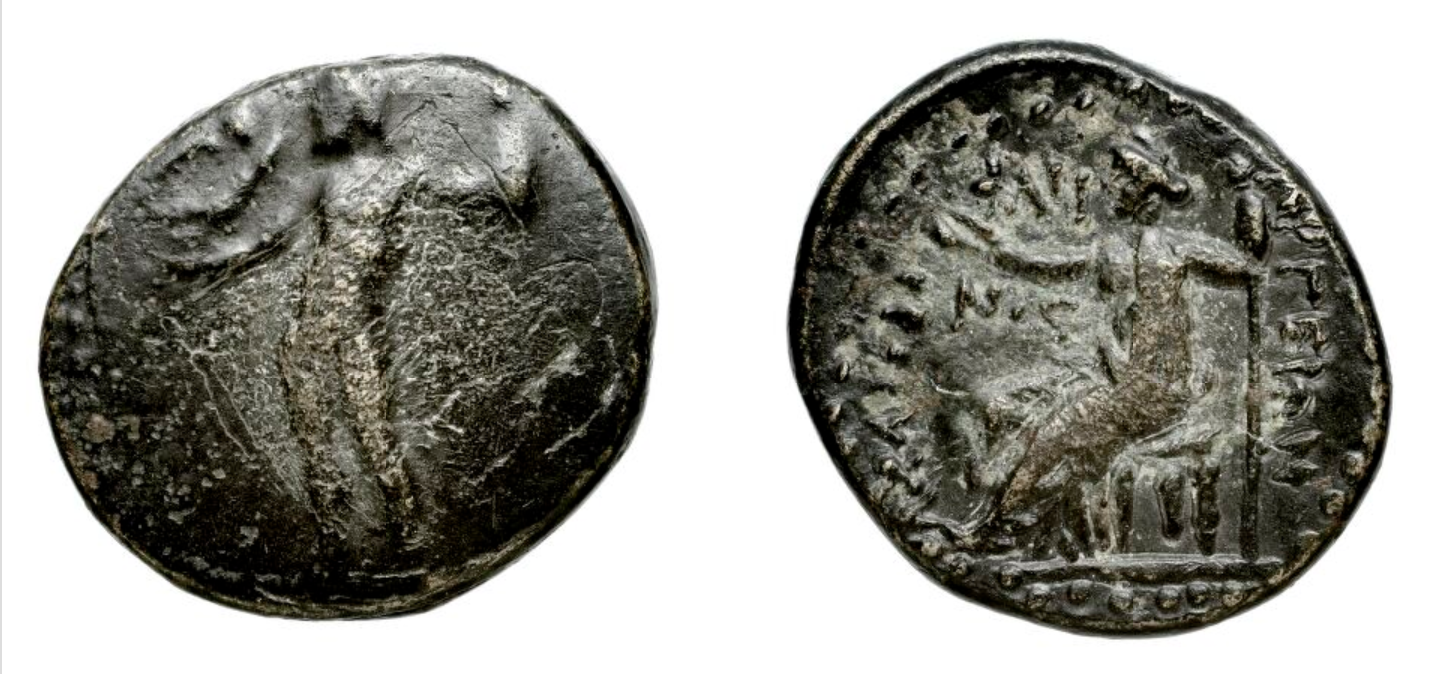Argos, bronze, 5g (standing Zeus/seated Achaea) (191-146 BCE)
From SILVER
191 BCE - 146 BCE Bronze
Description
| ObverseInscription or printing placed on the obverse.: | (APΓΕΙΩN) (Greek).Zeus Homarios left, naked, holding Nike stephanephoros in right hand and scepter in left hand. (In field, letter or monogram.) Border of dots. |
| ReverseInscription or printing placed on the reverse.: | (AXAIΩN or AXAIΩN APΓΕIΩN) (Greek).Personification of Achaea seating left, wearing chiton and peplos, holding wreath in right hand and scepter in left hand. In field, ΦΑHΝΟΣ. Border of dots. |
Mint and issuing power
| MintIdentifies the place of manufacture or issue of a numismatic object.: | Argos | Ancient regionAncient region.: | Peloponnesus | Modern countryModern country: Greece | AuthorityIdentifies the issuing power. The authority can be "pretended" when the name or the portrait of X is on the coin but he/she was not the issuing power. It can also be "uncertain" when there is no mention of X on the coin but he/she was the issuing power according to the historical sources: | Achaean League |
Chronology
| FromIdentifies the initial date in a range assigned in a numismatic context. | 191 BCE | toIdentifies the final date in a range assigned in a numismatic context.. | 146 BCE | PeriodTime period of the numismatic object.: Hellenistic 323-30 BC |
Physical description
| MetalThe physical material (usually metal) from which an object is made.: | Bronze |
Median weightMedian of the weights of numismatic objects (in grams). in grams | 5.00 | DenominationTerm indicating the value of a numismatic object. Examples: tetradrachm, chalkous, denarius.: | StandardStandard.: |
Image

S_360_-_Argos, _bronze, _191-146_BC.png [1]
References
| Die study referencePublication of the study: | Warren 20071Warren 2007, p. 7-10, n° 84-146. | ||
| Coin series referenceReference to coin series study: | BCD Peloponnesos2BCD Peloponnesos, n° 70, HGC 53HGC 5, n° 718 | ||
Obverse dies distribution
| FrequencyFrequency of specimen in distribution. ᵖ | Number of obversesNumber of obverse dies. ᵖ (o) | % (o) | Number of coinsNumber of coins. (n) | % (n) | Die nameName(s) of the die(s). |
| 1 | 32 | 69.57 | 32 | 50.79 | 2, 7, 9, 10, 11, 13, 14, 15, 16, 17, 18, 20, 22, 23, 24, 25, 27, 28, 29, 30, 31, 32, 33, 34, 35, 36, 37, 38, 41, 43, 44, 46 |
| 2 | 11 | 23.91 | 22 | 34.92 | 1, 3, 4, 5, 6, 12, 19, 21, 26, 40, 45 |
| 3 | 3 | 6.52 | 9 | 14.29 | 8, 39, 42 |
| Total | 46 of 46 | 100 | 63 of 63 | 100 |
Reverse dies distribution
no distribution is available
Quantification
| Number of obversesNumber of obverse dies. ᵖ (o) | 46 | Number of singletons (o1)The number of singleton coins. ᵖ | 32 |
| Number of reverse diesNumber of reverse dies. (r) | 55 | Number of coinsNumber of coins. (n) | 63 |
| Coins per obverse dieNumber of coins per obverse die. (n/o) | 1.37 | Coins per reverse dieNumber of coins per reverse die. (n/r) | 1.15 |
| Reverse per obverse ratioRatio of obverse dies divided by reverse dies. (r/o) | 1.2 | Percentage of singletons (o1)number of coins (n) divided by the number of singletons (o1) ᵖ | 69.57 % |
| Original number of dies (O) (Carter 1983 formula)The estimation of the number of coins according to Carter 1983 ᵖ | 135.29 | Coins struck if 20,000 as average productivity per dieCoins made if the average productivity for obverses (according to Carter) is 20,000. ᵖ | 2,705,800 |
| Original number of dies (O) (Esty 2011 formula)The estimation of the number of coins according to the singleton formula in Esty 2011 ᵖ (O) | 170.47 | Survival rate if 20,000 as average productivity per dieSurvival rate if average productivity is 20,000. ᵖ | 0.00002 |
| Coverage (o = % of O) (Esty 1984 formula)Esty 1984 - coverage (% of O) ᵖ (o = % of O) | 49.21% | Die productivity if survival rate 1/2,000Average productivity if survival rate is 1/2,000. ᵖ | 931.33 |
| Weight of silver (in kg) if 20,000 coins per die (O = Carter formula)Carter 1983 * Median weight * 20000 (*10 if gold or electrum) ᵖ | n.a. | Die productivity if survival rate 1/5,000Average productivity if survival rate is 1/5,000. ᵖ | 2,328.33 |
Remarks
References
- ^ Warren, Jennifer A. W. (2007), The Bronze Coinage of the Achaian Koinon. The Currency of a Federal Ideal, Royal Numismatic Society Special Publication 42, London, xvi, 212 p., 39 pl.
- ^ LHS Numismatics, 96 (Coins of Peloponnesos. The BCD Collection), 8-9 May 2006 (1775 lots)
- ^ Hoover, Oliver D. (2011), Handbook of Greek Coins 5. Coins of the Peloponnesos, Achaia, Phleiasia, Sikyonia, Elis, Triphylia, Messenia, Lakonia, Argolis, and Arkadia, Sixth to First Centuries BC, Lancaster (PA), 2011.